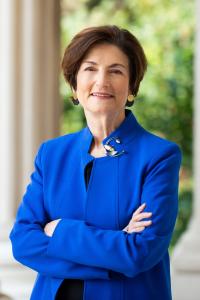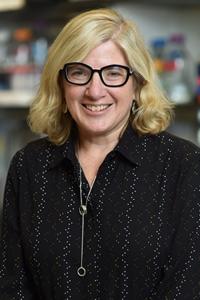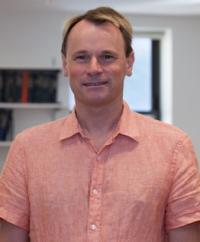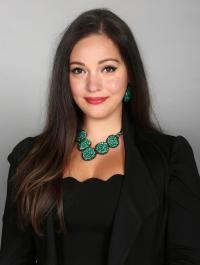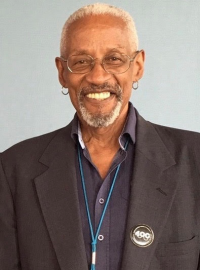
Community at the Center
Faculty, staff, and students from Columbia Mailman School are working with New York City neighborhood residents to shed new light on persistent public health challenges.
Columbia Mailman School already had a century-long history of developing research partnerships, facilitating student practica, and collaborating to improve public health in Northern Manhattan. Then COVID-19 hit. When the School’s leaders saw how longstanding health inequities fueled the pandemic’s devastating effect on the neighborhood, they knew they had to do more. And so, in 2021, under the guidance of Dean Linda P. Fried, MD, MPH, the School began to lay the groundwork for a Community Health Equity Collaborative (CHEC), launched in 2024, that would build new academic-community partnerships, accelerating efforts to decrease health inequities and improving the health of neighboring communities. Today, Columbia Mailman School is doing more than ever to reach out to those who live in the community and to its churches, nonprofit organizations, religious institutions, and advocacy groups.
Doing More Listening
In the field of public health, two or three decades ago, the norm was that experts communicated to the public when there was certainty. “That model said, ‘I don’t want to create stress about health risks, particularly environmental ones, until I know there is sufficient data,’” says Mary Beth Terry, PhD ’99, a professor of Epidemiology and Environmental Health Sciences who has been at Columbia Mailman School for 25 years, first as a PhD student and then as a faculty member.
Today, community organizations are increasingly partners from the ground up. “Ideas are first discussed with community advisory boards to get their input on whether a project is worthwhile,” says Terry. “The ‘deficit’ model of communication has been replaced with a ‘dialogue’ model. The deficit model is linear. The dialog model is a circle: You still have scientists with disciplinary expertise, but you also have community members who have their own expertise, and policymakers. And we acknowledge that science evolves constantly so we have to communicate on an ongoing basis.”
You can see that circle in action in a collaborative effort underway between the School’s scientists and activists in the South Bronx. The South Bronx experiences heavy truck traffic, and air pollution has had a devastating effect on the health of its residents, most of whom are low-income people of color. The area has one of the nation’s highest rates of asthma, with 1 in 4 children affected. The Mott Haven neighborhood is often referred to as “Asthma Alley.”
A research project organized by environmental justice group South Bronx Unite and environmental health scientists at Columbia Mailman School has installed 25 air pollution monitors in strategic locations throughout Mott Haven and nearby Port Morris, with a control monitor in the affluent, tree-filled western Bronx neighborhood of Riverdale, which has fewer industrial sources of particulate matter.
This research is driven by the community’s needs and designed to answer its questions. It is modeled on an earlier collaboration that used monitors to document traffic related to the opening of a grocery warehouse. “We were able to highlight the environmental impacts of the new facility on the community,” says Markus Hilpert, PhD, associate professor of Environmental Health Sciences and one of the project’s leads. The findings were published in peer-reviewed journals and disseminated to community members through outreach events. The research has helped South Bronx Unite fight land use and transportation policies that would increase traffic in the community.
The researchers’ latest effort, funded through the New York State Department of Environmental Conservation, has more than tripled the number of sensors of the previous project, allowing for more detailed analyses as they measure, minute by minute, levels of particulate matter, carbon monoxide, ozone, and other substances. An anemometer, which measures wind speed, helps pinpoint air pollution sources.

The Santos Pimentel family of the Bronx is part of an indoor air study.
Community-generated research ultimately cycles back to community organizations, which advocate for policy changes that foster health. Peer-reviewed research conducted with Columbia Mailman School scientists helped a coalition of advocacy groups co-led by South Bronx Unite to successfully lobby for New York state’s cumulative impacts law, which is designed to prevent the approval and reissuing of permits for actions that would increase inequitable pollution burdens on disadvantaged communities.
Terry is leading another air pollution research project in Washington Heights and the Bronx that is looking at indoor air quality. The team equipped families with HEPA air purifiers and measured inflammatory biomarkers for chronic disease. They also provided the families with “green” cleaning products and an educational video about environmental and lifestyle risk factors and chronic disease risk reduction strategies. Families such as Marileidy Pimentel, Juan Santos, and their daughter Bermarys, who live in the Bronx, aren’t in the dark as study participants— they’ve been asked for their feedback as the project has unfolded. “Despite 30 years of research, chronic diseases were not reduced across all groups,” says Terry. “So our old model of communicating with communities didn’t work. Now this idea of having community involvement in lots of projects versus only special projects is becoming the norm. The National Cancer Institute now requires scientists to understand what is relevant to the community and how to have an ongoing dissemination of information related to the cancer burden there. And funders increasingly emphasize how the work being done reduces health disparities, versus only reducing disease risk.”
Doing More Connecting
Connecting with the community includes forging partnerships with nonprofits that have deep roots in specific populations. Nour Makarem, PhD, assistant professor of Epidemiology, is leading a first-of-its-kind Food Is Medicine clinical trial in New York City in partnership with the nonprofit God’s Love We Deliver (GLWD). The trial began enrolling participants in August, with a focus on recruiting in Harlem and Washington Heights. A conversation between Makarem and Kelly V. Naranjo, MS, manager of research and evaluation at GLWD, was the impetus for the project and other nonprofits have since signed on.

Nour Makarem (left) and students with Kelly Naranjo (far right) at God’s Love We Deliver (GLWD).
The study’s goal is to help determine how to enhance the effectiveness of medically tailored meals (provided by GLWD) among people who have multiple risk factors for heart disease, such as Type 2 diabetes and high blood pressure. Among those with more severe disease, who qualify for medically tailored meals, the research is examining whether supplementing meal delivery with a culturally relevant heart health curriculum will result in improved diet quality and better blood sugar and blood pressure metrics. “We have joined with Ryan Health, a community healthcare provider, and partnered with the nonprofit Harvest Home Farmer’s Market to implement community-centered nutrition education, including cooking demonstrations and fresh produce bags,” Makarem says. Among a second group of people who have less severe disease and don’t currently qualify for meals, the study is examining whether introducing the special meals earlier in the course of disease might forestall problems and, if so, what “dose” of meals is most impactful and cost effective. The American Heart Association is funding the research.
“A really big piece of community-engaged research is having your finger on the pulse of what is important to people, what works, and what doesn’t,” says Makarem. Students involved in the study are learning this firsthand. They began volunteering with GLWD in the weeks leading up to the study and engaging with the communities they would be recruiting from by screening for diabetes and high blood pressure at neighborhood health fairs. Now, they are recruiting patients and administering questionnaires to the 200 residents who will participate in the study, scheduling them for program appointments, and keeping them engaged for eight months.
Along the way, students get a firm understanding of community-engaged and community-led research, and the hurdles that researchers face. “The students are great at working with participants in different neighborhoods, from different backgrounds. They are learning how to implement contextual interventions and how we are in ongoing conversation with the community as the study progresses,” Makarem says.

Air pollution is a focus of research and advocacy in the South Bronx.
Doing More Learning
The Food Is Medicine study is hardly the only current research that engages students with community members. The CHURCH trial (CHURCH stands for Community Health workers United to Reduce Colorectal cancer and cardiovascular disease among people at Higher risk) focuses on colorectal cancer awareness in collaboration with Black churches in Harlem and the Bronx. It is a National Institutes of Health– funded research study based at Columbia University Irving Medical Center. CHURCH partners with community health workers from the churches to engage New York City residents aged 45 and older who are not up to date with colorectal cancer screening. It’s just one of the projects spearheaded by the Columbia Center for Community Health, which is co-led by Robert E. Fullilove, EdD, associate dean for community and minority affairs and professor of Clinical Sociomedical Sciences at Columbia Mailman School, and Olajide A. Williams, MD, MS ’04, professor of Neurology and vice dean of community health at the Columbia University Vagelos College of Physicians and Surgeons.
CHURCH draws many of its research assistants from Columbia Mailman School’s student population. “Working in the community is often interdisciplinary, cross-School, student-involved work, and it takes place in New York City— all things that make Columbia Mailman School a truly distinctive place to study,” notes Kathleen J. Sikkema, PhD, chair and Stephen Smith professor of Sociomedical Sciences. Valerie Kim, MPH ’25 , joined as a research assistant earlier this year. She attends health fairs and church events, where she works alongside community members—and fellow students such as Tobechi Dimkpa, MPH ’25, and Hersh Pareek, MPH ’25—to recruit study participants. Kim has found community- based research to be a valuable learning opportunity. “Sometimes in an academic environment you fall into being told things. You learn about a health issue, but hardly do you experience or talk to people dealing directly with it. Being part of community-based research has been meaningful in that regard. I learn in class, but then I see something out in the community, and I can connect the two.”

CHURCH trial recruitment at Convent Avenue Baptist Church in Harlem.
Doing More Going Forward
Much of the current research was already under way when, as a natural outgrowth of its work on health equity and justice, Columbia Mailman School announced that it was launching CHEC, housed in the Dean’s Office, with the goal of continuing and expanding innovative partnerships with Northern Manhattan communities to address complex underlying causes of health inequities and better improve health.
Faculty members Kelli Hall, PhD ’10, an associate professor of Population and Family Health, and Alwyn T. Cohall, MD, professor of Public Health and Pediatrics at Columbia University Irving Medical Center and Columbia Mailman School, led an extensive project to plan the new effort and identified more than 50 active community partnerships already run by departments, individual faculty members, administrative offices, and student groups. ICAP at Columbia was rolling through Harlem and the Bronx with a mobile clinic, evaluating whether using mobile health units to deliver integrated health services for people with opioid use disorder could improve HIV and substance use treatment and prevention. And for close to a decade, Daniel P. Giovenco, PhD, MPH, an assistant professor of Sociomedical Sciences, had been examining how minority communities are disproportionately targeted with ads for the deadliest tobacco products and looking at the link between tobacco use and neighborhood characteristics, such as tobacco retailer density, local tobacco control policies, and exposure to product advertising.
But while the breadth of the School’s partnerships was strong, “as meaningful as the School’s public health work has been to date, it has not been enough to fully offset the structural and societal issues that create disparities in the opportunity for health,” says Fried. “Addressing the underlying causes of health inequities in Upper Manhattan and the U.S. as a whole is a complex challenge that requires new solutions and partnerships between community, academic, and other organizations.” This School-wide centralization of CHEC within the Dean’s Office will ensure that collaboration with partners across departments and centers is coordinated to support outcomes.
CHEC is designed to be a true collaboration with the community, with neighborhood members receiving training on community-based participatory research (to enhance their capacity to collaborate with academic researchers) and community leaders helping the School’s faculty and staff to set goals and design service-learning projects for students that would foster learning in real-world settings. “This office is a lever we can use to dislodge health inequity and create conditions to foster health equity, while also creating a model of how academia can engage with the community respectfully,” says Ana Jimenez-Bautista, who was named executive director of CHEC in September and will fully assume her new role in 2025.
Successful public health interventions will likely require integration or consideration of many of the disciplines represented at Columbia University—from architecture to engineering to medicine. CHEC will provide the University with an umbrella for cross-discipline initiatives that can be guided by Columbia Mailman’s deep history and experience in New York City community engagement. The CHEC office will work with community members to jointly identify health priorities and the opportunities for successful intervention, with support of academic data science capabilities and implementation science. Three examples of interdisciplinary areas CHEC might focus on are trauma (which has a significant intergenerational impact on mental and physical health); support for formerly incarcerated individuals (including health support but also education, housing, and jobs); and neighborhood conditions such as pollution and food insecurity.
Jimenez-Bautista, who has worked in Northern Manhattan since 1989 and had roles at Columbia Mailman School for a decade, feels the time is right for the School to engage more deeply and cohesively with these long-standing challenges. “Thanks to Dr. Bob Fullilove and others like Dr. Williams, community-based participatory research has blossomed. We have talent and the interest from many of the faculty here in community-based research.” The School already has a 25-year history of partnership with WE ACT, the West Harlem environmental action coalition that has explored environmentally driven causes of poor health. But more can be done, and students are eager to participate. Says Jimenez-Bautista, “The students are coming in with more interest in prevention, in starting upstream of many of the health problems we are seeing, and engaging the common person in active participation. There are more robust student organizations at the School working on community engagement. I’ve seen a qualitative change since the pandemic—if you say, let’s talk about community, there are immediately ten students who raise their hand. That wasn’t always the case.”
Dana Points, the editor of this magazine, lives in Harlem.
Community at the Center was first published in the 2024-2025 issue of Columbia Public Health Magazine.


